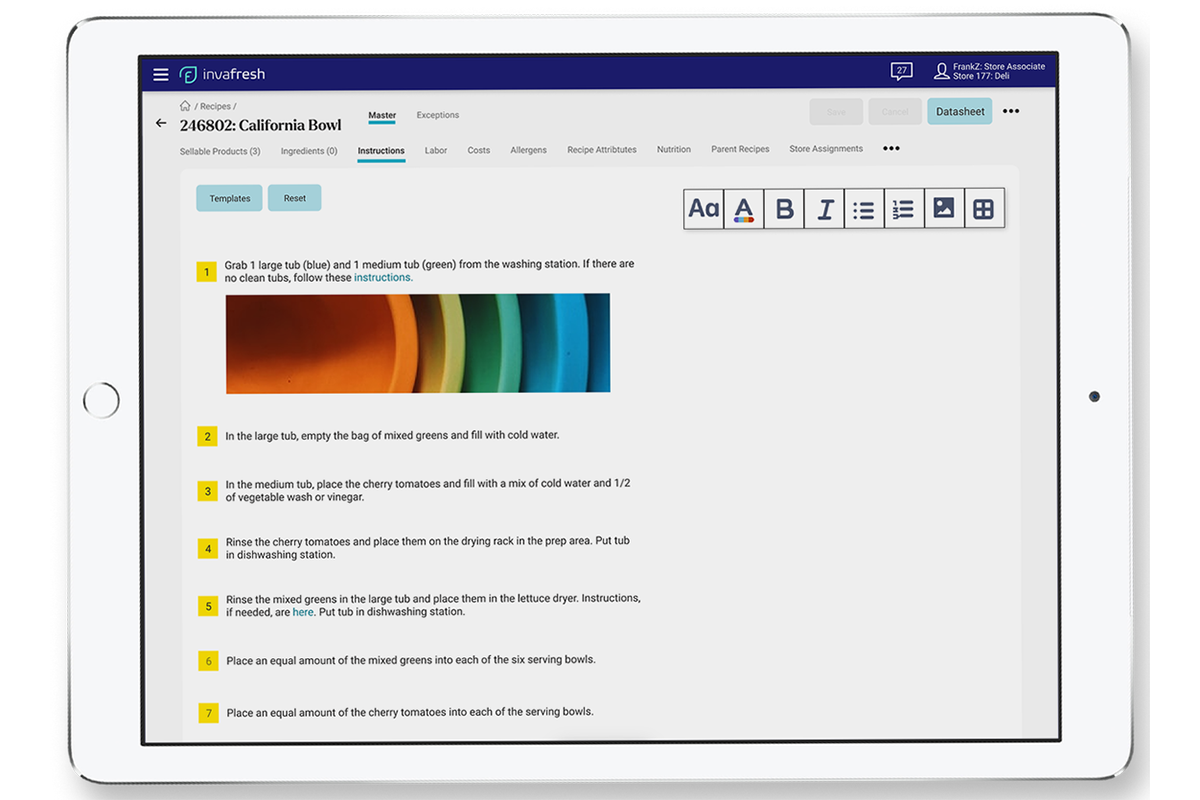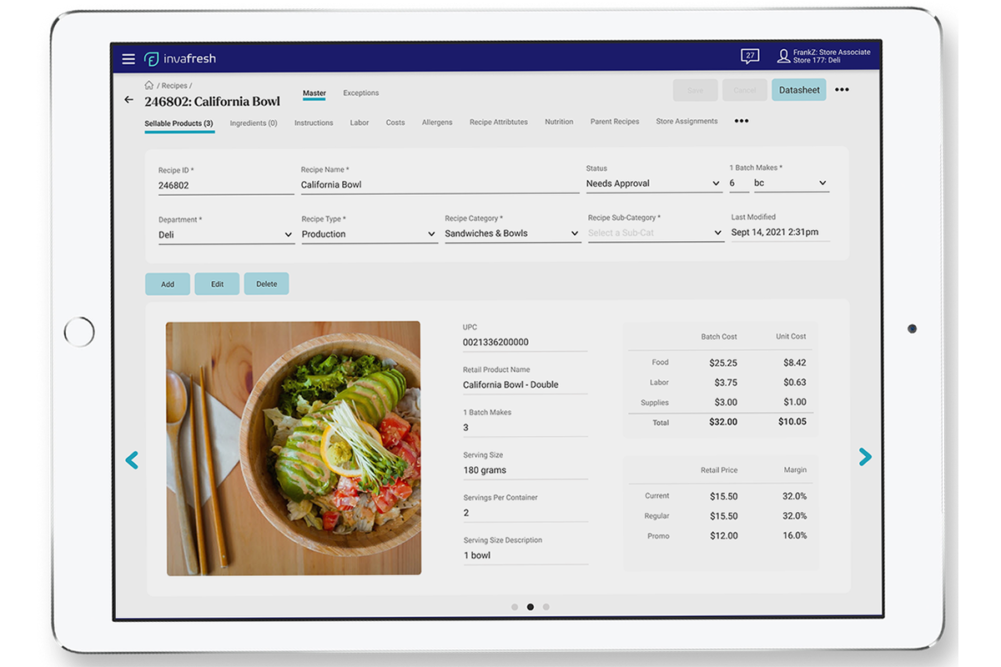Recipe management software has become much more important for grocery prepared foods sections and for the other departments that make up the fresh perimeter.
There are several reasons for this, said Stephen Midgley, vice president of marketing for Toronto-based Invafresh.
One is efficiency and accuracy. Recipe management software streamlines the process of managing recipes, ingredient sourcing, and production planning.
“It eliminates the need for manual calculations and reduces the chances of errors. This efficiency improves overall operations and saves time for staff.”
Another reason is increased standardization and consistency. Consistency, Midgley said, is crucial in the prepared foods sections of grocery stores.
Recipe management software allows for standardized recipes, ensuring that the same quality and taste are maintained across different batches of prepared foods, which helps build customer trust and satisfaction.
Better inventory management is another reason to switch to recipe management software, Midgley said.
“Recipe management software helps in tracking ingredient inventory levels, ensuring that the necessary ingredients are always available for food preparation. It enables better inventory control, reduces waste, and minimizes the risk of running out of key ingredients.”
Other reasons to switch from manual to automated recipe management programs like those made by Invafresh include:
Cost Control
By accurately tracking ingredient quantities and costs, recipe management software assists in controlling food costs. It provides insights into ingredient usage, portion sizes, and recipe profitability, enabling better pricing decisions and cost management.
Compliance
Recipe management software assists in adhering to regulatory requirements related to ingredient labeling, allergen management, and food safety. It helps ensure compliance with food safety standards and simplifies the process of audits and inspections.
Scalability
As the demand for prepared foods increases, recipe management software facilitates scalability. It enables grocery stores to handle larger volumes of production, manage multiple locations, and streamline operations as they expand their prepared foods sections and retail foodservice offerings.
A solution for every problem
Invafresh specializes in providing a range of products and services specifically designed for recipe management in the grocery industry, Midgley said.
 Source: Invafresh
Source: InvafreshOne of the company’s key offerings is a comprehensive recipe management solution, a component of its Fresh Retail Platform tailored to meet the unique needs of retailers and helps them build and maintain a profitable recipe database.
With Invafresh’s recipe management software, Midgley said, retailers can easily create and manage their recipe collection. The software provides a user-friendly interface where retailers can input and store detailed recipe information, including ingredients, quantities, preparation instructions, and nutritional data. This centralized database allows for efficient organization and quick access to recipes.
Another notable feature of Invafresh’s recipe management software is its integration capability. It seamlessly integrates with other solutions, such as production planning, Midgley said.
“This integration ensures that ingredient pricing is up to date in real-time, avoiding any potential profit margin compromises. By tracking ingredient costs and providing accurate pricing information, retailers can make informed decisions about recipe profitability and adjust pricing strategies accordingly.”
Prepared foods: more demand, new challenges
As competition increases, “the game is being upped” for prepared foods being sold in retail foodservice and other channels, said Wynne Barrett, a partner in Hopkinton, Mass.-based Jera Concepts, which specializes in helping producers streamline their recipe management procedures and making sure that labels on foods list the correct ingredients.
Pizza and sushi, he said, are just two of the categories that are seeing big gains in innovation and quality at the instore level.
With that bar being set ever higher, it’s increasingly important, Barrett said, that recipes be as accurate as possible. That’s where recipe management comes in.
An effective program combines cutting-edge software with effective management at the production end and good old common sense.
When it comes to recipes, it’s often the case, Barrett said, that the simpler, the better.
“If a recipe’s too hard to execute, it won’t get done right,” he said.
For the past couple of years, Jera has partnered with Datassentials to target trending recipes that can often be identified by a certain buzz word, like “chipotle” or “aioli.” The challenge is to build a recipe that’s both trendy and simple to execute, Barrett said.
One thing recipe management software is great it is helping retailers and other users keep costs under control, Barrett said.
“The cost of fish, for instance, is high, so it’s very important to follow a recipe accurately.” The surge in demand for sushi in grocery prepared foods departments drives home the importance of that.
Software also helps make sure that the right kind of a particular product is used. That problem was exacerbated during the pandemic, with the worldwide supply chain woes. It’s abated somewhat, but still can be a challenge, Barrett said.
“A big challenge in prepared foods is, as product substitutes come in, you could have, for instance, three different chicken breasts with three different salt counts.”
Jera, for its part, is working to continually simplify the interface of its products to make the management of nutritionals and other information easier. The same applies to label printing.
What’s next in recipe tech
Cloud-based solutions
Cloud technology offers several benefits, including easy accessibility, real-time updates, and enhanced collaboration.
AI-driven recipe recommendations
By analyzing user preferences, dietary restrictions, and ingredient availability, AI-powered recipe management systems can suggest tailored recipes.
Mobile Applications
They offer on-the-go access to recipe databases, shopping lists, and cooking instructions.
Blockchain for traceability
By recording and securely sharing information, blockchain can enhance food safety and enable consumers to verify the authenticity and quality of ingredients used in recipes.
Source: Invafresh

